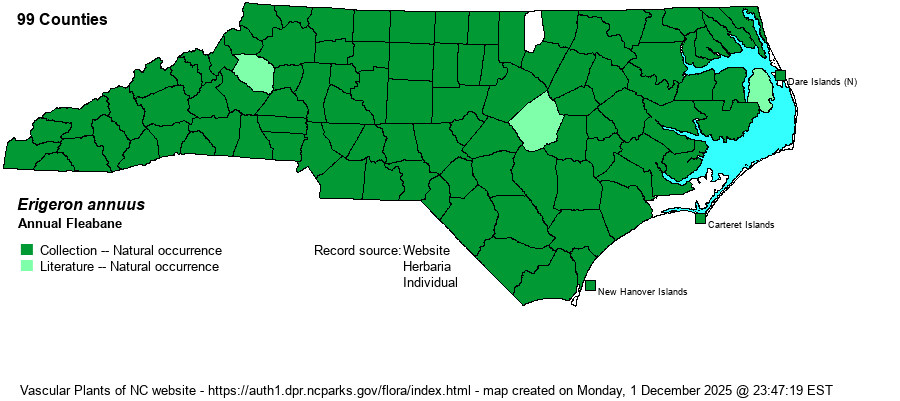| Author | (L.) Persoon | |
| Distribution | Throughout the state; apparently local on barrier islands.
Newf. to B.C., south to northern FL and TX; Mexico (rare), C.A. | |
| Abundance | Generally common across the state, except rare on the Outer Banks. | |
| Habitat | Mesic to moist or dry, rather fertile, soils of meadows, fields, cropfields, roadsides, waste places, vacant lots, yards, and gardens. These habitats are very similar to the equally numerous Prairie Fleabane (E. strigosus). The original natural habitats in NC are not known. | |
| Phenology | Flowering and fruiting May-October. | |
| Identification | Annual Fleabane grows mostly 2-3 (-4) feet tall, with hairy stems. Basal leaves are usually absent by flowering time. Stem leaves are broadly lance-shaped to elliptic, the outer end broader than the inner, length mostly 2-4 inches, and margins toothed. The terminal heads are on short branches; each head has a broad yellow disk and 80-125 skinny, white rays 5-10 mm long. Prairie Fleabane also lacks basal leaves at flowering. However, it is not as tall (at most 3 feet), stems and leaves are narrower, leaves are fewer, and stem hairs are much shorter and essentially appressed (vs. spreading). Philadelphia Fleabane (E. philadelphicus) may look similar at a distance, but it has well-developed basal leaves and rays are tinged pink (but may be white). | |
| Taxonomic Comments | None
| |
| Other Common Name(s) | Eastern Daisy Fleabane, Daisy Fleabane (used for several species) | |
| State Rank | S5 | |
| Global Rank | G5 | |
| State Status | | |
| US Status | | |
| USACE-agcp | FACU link |
| USACE-emp | FACU link |

